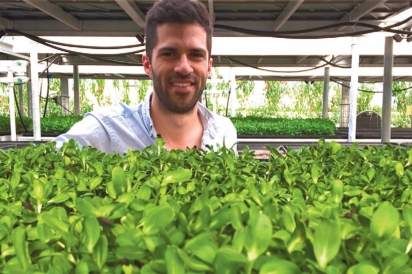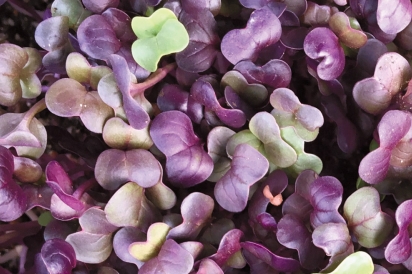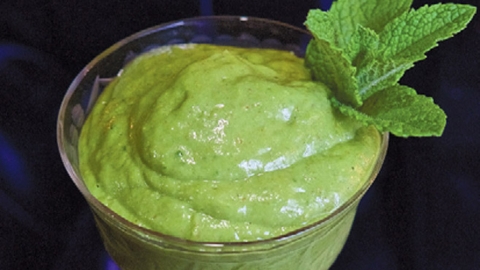Microgreens:Emerging Urban Agriculture
Microgreens have been used in fine dining for almost 30 years, mainly as a garnish. Lately they are showing up at the farmers’ markets, where microgreen growers snip samples to tempt passersby.
So exactly what are microgreens? They’re edible greens grown from the seeds of vegetables and herbs. They’re smaller than baby greens and bigger than sprouts. Micro-greens germinate in soil or soil substitutes, require sunlight for growth and are harvested when they’re seven to 14 days old and one to three inches tall. Their flavor is much more intense than that of mature greens.
Arizona Microgreens
Wanting to find out more, I visited the largest producer in our state: Arizona Microgreens. I meet the owner, Joseph Martinez, in a spacious 1,300-square-foot greenhouse in the middle of Phoenix. Joseph and his co-owner and brother, David Redwood, are grooving to music and filling trays with potting soil and different kinds of pre-soaked seeds. He waves me over with a big smile.
“Here, try this,” he says. He starts snipping micro-bouquets from dense green growing flats. “What do you think this is?”
He puts me through his taste test. The flavors are fresh and snappy, slightly sweet or sharp, tangy and spicy.
“Taste just like peas, sweet,” I say. “That one’s cilantro and this one is dill. Whoa, that’s red, must be cabbage or radishes.”
The micro leaves are delicate and beautiful. This is fun but what’s the big deal, really? They are so very tiny.
Joseph and his brother started planting microgreens about four years ago. Both had been off to college, traveled, worked and lived in a half dozen places from Berlin to Bolivia. They came home to Cave Creek to experiment with urban agriculture and started Arizona microgreens in a very small greenhouse.
Cave Creek is also home to the Hell’s Angels. Joseph remembers when one of the bikers strode up to the greenhouse and gruffly asked for a sample. “My body likes this,” he said. That’s when Joseph knew he was on the right track.
As I move on to more tastes—the sweet little green corn shoot and then the even sweeter yellow version (grown without light)—I’m getting the same feeling: “My body likes this.”
Joseph explains that he eats microgreens at every meal and they fuel his high-energy life style. For breakfast, he throws a handful into a smoothie. Lunch at work is a microgreen salad with added chicken or beans for protein. Microgreens are the vegetable-in-residence on his dinner plate. The beauty is that they don’t need any preparation. They’re too delicate to be cooked and already taste great. Anywhere you drop them, they are sensational.
Arizona Microgreens has grown from the backyard greenhouse to supplying over 20 varieties to farmers’ markets, restaurants from Tucson to the Grand Canyon, Phoenix Children’s Hospital and classrooms for the federal healthy snack program.
Maxwell Gardens
One week later I visit Maxwell Gardens in the high prairie north of Prescott Valley. Laird Maxwell is an Idaho country boy and a retired “politicking” lobbyist. He has a jolly green Santa-Claus demeanor and he chuckles as he shows me around his micro-mini farm. About five years ago he acquired this farmers’-market-based micro-green business from a friend. He grows pea, sunflower and popcorn (which he calls green popcorn) microgreens. His best sellers are “take-home trays” of mixed broccoli, mustard and radish greens, a little fresh microgreen garden patch for your very own kitchen. His market approach is about the same as the big city boys: snipping and handing out samples. The reaction is usually “My body likes this” and they come back for more.
Laird hails from a beef and sheep ranch and prefers his sunflower microgreens on a ham-cheese-egg-and-tomato sandwich or paired with home-cured pork belly. He talks about their super nutrition and great taste and smiles broadly. Then we take a tour of his newly constructed, yet to be planted, 720- square-foot greenhouse. Microgreens are definitely expanding.
Growing Green(s)
Both young urban entrepreneur and semi-retired micro-farmer operations use organic methods (though they are not organically certified). Insects, pests, diseases and weed problems are nonexistent. Microgreens grow in seven to 14 days in a controlled environment. They can be grown year-round in much less space than any other food plant. Water goes directly on the plants with no cooler runoff or spillage. Waste from cut flats is composted. In the summer, Arizona Microgreens uses evaporative cooling. Even the coolers’ runoff is used for watering. Maintaining a controlled environment in the summer in Phoenix and in the winter in northern climates does have costs, but urban agriculture fills empty spaces like city rooftops, abandoned warehouses and home kitchen counters. It’s extremely local, cutting transportation costs and delivering fresh greens within a few miles of production. It’s a growing solution to food of the future.
Even though microgreens are an excellent potential food crop, no nutritional analyses were run until five years ago. In 2012 a report funded by the USDA was published in the Journal of Agricultural and Food Chemistry. Researchers looked for powerful antioxidants like vitamins C, E, K and beta carotene (related to vitamin A) in 25 different types of microgreens. They found that, depending on the variety, microgreens contained four to 40 times more nutrients than their mature versions. Researchers were so amazed with their findings that they re-ran the tests a couple of times to triple check their results.
Microgreens save labor in the kitchen because they don’t need to be—and shouldn’t be—cooked. They’re tender and delicate and delicious eaten raw. And why not? They taste great. Microgreens substitute for lettuce in salads, sandwiches, burgers and tacos. Consider them the good-to-go vegetable on your dinner plate. Sweet pea and sunflower microgreens make great snacks as is. Because they are so very fresh, usually harvested the day they are sold, they will keep for five to seven days refrigerated. A living tray of microgreens makes a stunning centerpiece for a dinner party.
Microgreens aren’t in many stores yet, but they’re coming soon. They’re an emerging product; there will be more. Try them out and see what your body has to say. It just might be “I like this.”
Sourcing Microgreens
To buy microgreens you'll probably have to shop the farmers' markets or order them online.
- Arizona Microgreens appears at the farmers' markets in Carefree, Uptown Phoenix and Old Town Scottsdale every week. You can order directly for pickup at the greenhouse or at the farmers' markets or get delivery to home ($50 minimum) or business ($75 minimum). See arizonamicrogreens.com.
- Maxwell Gardens is a regular at the Prescott and Prescott Valley farmers' markets.
Grow Your Own Microgreens
Want very fresh and cheap microgreens? Grow them. It's a basic and easy introduction to gardening right in your own kitchen. Check out these links for more information.
- This Old House, How to Grow Microgreens youtube.com/watch?v=TwLxkOSG4gU&t=260s
- Upstart University, How to Grow Microgreens, Beginners university.upstartfarmers.com/blog/how-to-grow-microgreens-beginners-guide










